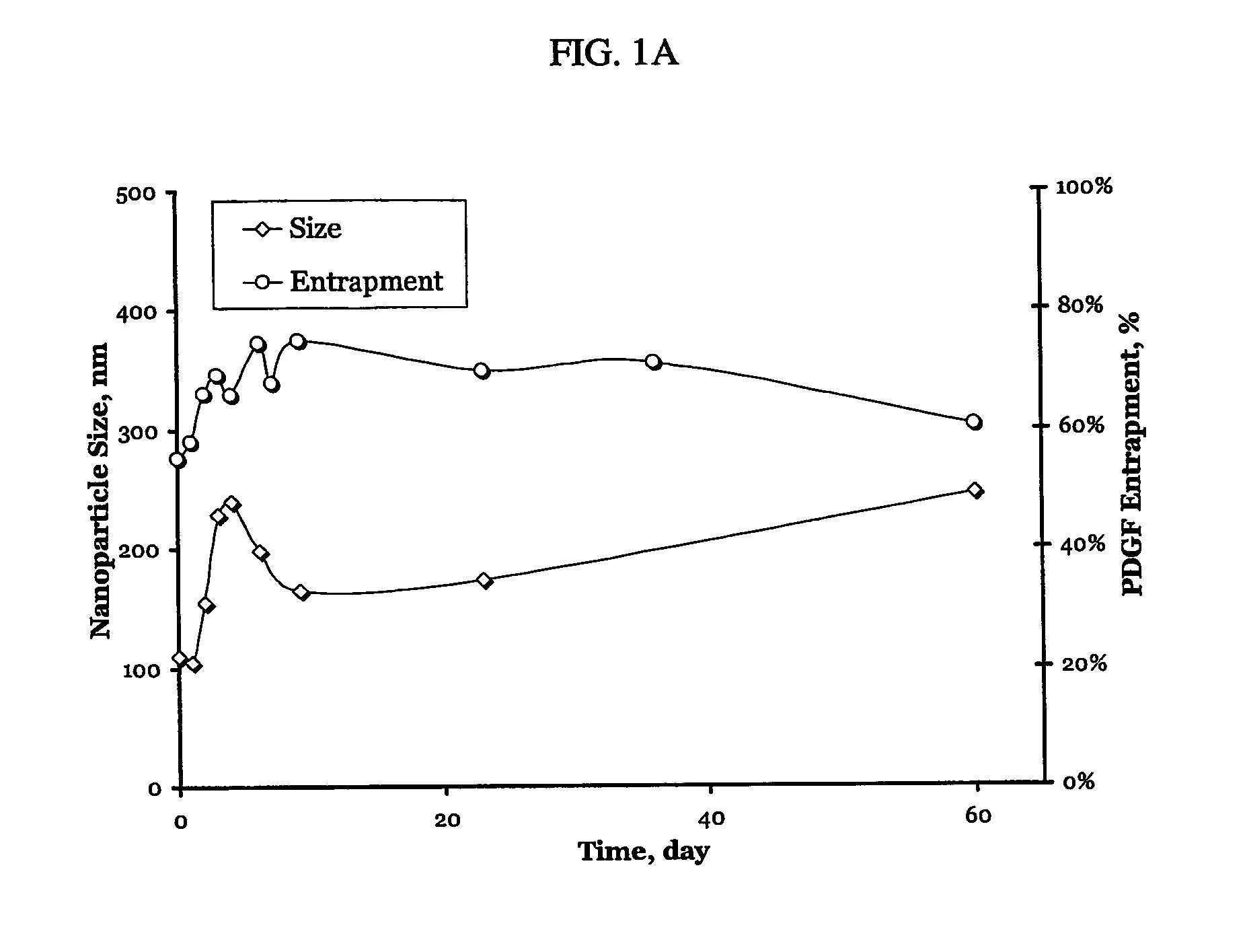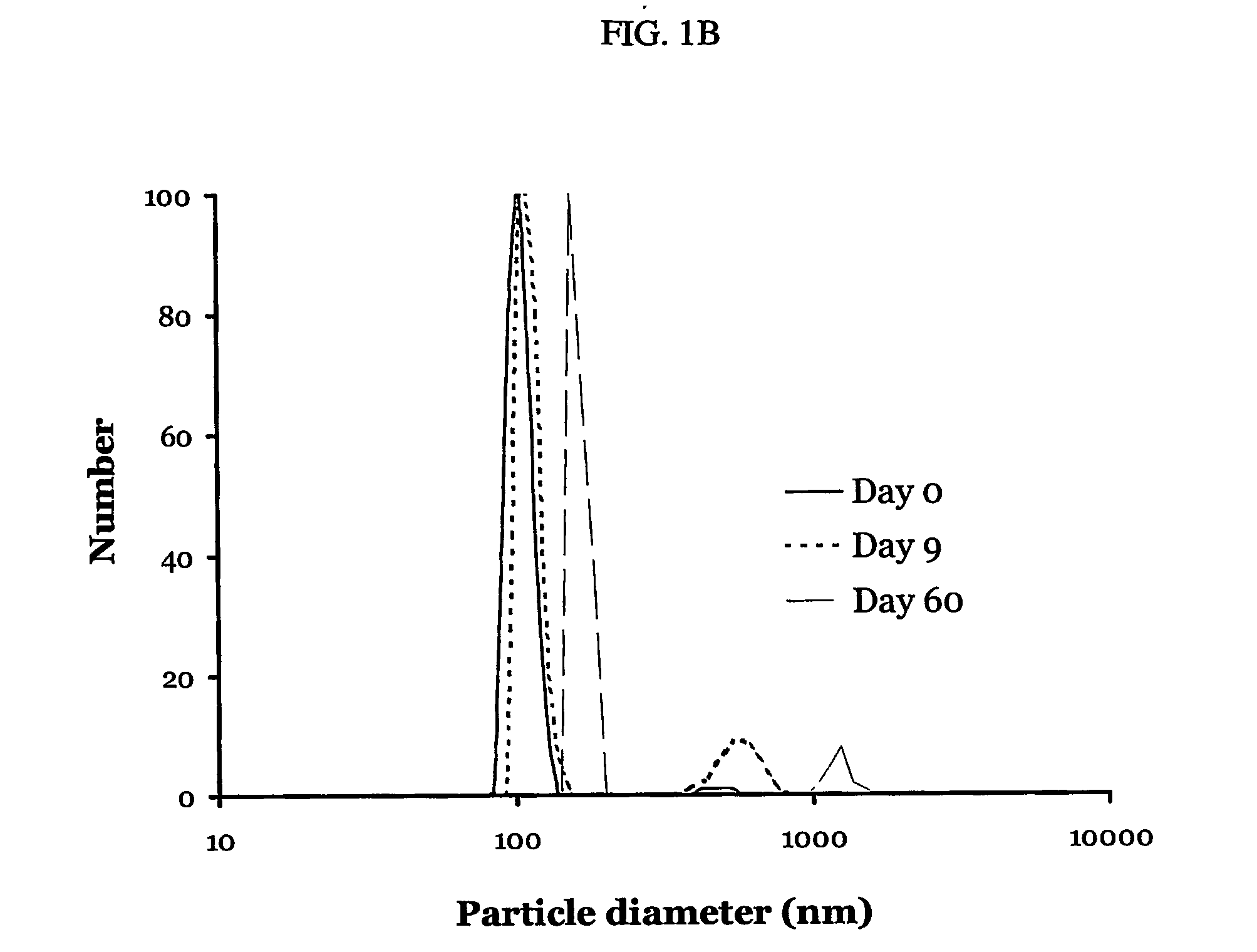Sustained release preparations composed of biocompatible complex microparticles
a technology of complex microparticles and suspension preparations, which is applied in the field of microparticle and nanoparticle compositions, methods, etc., can solve the problems of structural and functional damage to proteins and peptides
- Summary
- Abstract
- Description
- Claims
- Application Information
AI Technical Summary
Benefits of technology
Problems solved by technology
Method used
Image
Examples
example 1
Method of Making Particles
[0126] Solution A: dextran sulfate was dissolved in purified water in concentration 1% w / v.
[0127] Solution B: PDGF-BB was dissolved in aqueous solution of glucose (5% w / v) to yield 1 mg / ml; pH was adjusted to 6.0 by acetate buffer (0.005% w / v) or MES buffer (0.001 M).
[0128] Solution A was added dropwise to solution B on magnetic stirring to the final volume ratio 100-150 μl:10 ml. The obtained particle suspension was filtered through 6 μm paper filter to remove aggregates.
[0129] The PDGF-binding particles can be used as is or upon dilution (preferably with low ionic strength media, such as glucose 5% solution in MES buffer (pH 6.0), 0.001 M). Optionally, the particles can be stored freeze-dried and used after re-suspension in purified water or another suitable medium. The particle preparation maybe accomplished under sterile conditions yielding a ready-to-use product or sterilized by a suitable method (irradiation, sterile filtration) prior to injectin...
example 2
[0130] PDGF / dextrane sulfate particles prepared as described in Example 1 were studied for size and entrapment / loading as shown in FIG. 1A. FIG. 1A demonstrates efficient entrapment and a uniform (200-250 nm range) particle size.
[0131] Labeling of the bioactive agent (PDGF) was conducted as follows: 3.0 mg of carboxytetramethylrhodamine N-hydroxysuccinimidyl ester was mixed with 4.0 ml PDGF-BB solution (10 mg / ml, acetate buffer pH 6.2), and 900 μl of bicarbonate buffer (pH 8.5, 0.1 M). The mixture was stirred for 5 minutes on a vortex, and placed in the dark at room temperature for 1 hr, then dialyzed overnight (molecular weight cut off 2000 KDa) in 1 L of acetate buffer (pH 6.0, 0.005%).
[0132] Size determination was conducted as follows: 60 μl of particle suspension were added to 3.0 ml of MES buffer (pH 6.5, 0.001 M), and their size measurement was performed by photon correlation spectroscopy for 2 minutes and presented as a number-weighted size distribution. Size stability was ...
example 3
[0135] Dextran sulfate-PDGF particles were prepared as described in Example 1. The preparation was examined for release kinetics. A release medium was prepared in a sterile fashion by (a) adding 0.5 ml MES buffer (pH 6.5, 0.1 M) to 50 ml saline (0.9% NaCl in deionized water) (see FIG. 2A) and (b) adding 0.5 ml MES buffer (pH 6.5, 0.1 M) to 50 ml bovine serum albumin / saline (5% albumin and 0.9% NaCl in deionized water) (see FIG. 2B). 2.5 ml of the particles were mixed with the release medium, transferred into a 60-ml syringe equipped with a 0.02 μm sterile filter. The syringe was placed on a LABQUAKE shaker (Apogent Technologies, Inc., Portsmouth, N.H.) at room temperature in the dark. At predetermined time points, a 100 μl sample of the release medium was filtered following extraction of the first 10 drops to be discarded. The amount of fluorescently labeled protein was determined in comparison to a sample of particle suspension in the release medium, which was kept in the dark at r...
PUM
| Property | Measurement | Unit |
|---|---|---|
| Fraction | aaaaa | aaaaa |
| Fraction | aaaaa | aaaaa |
| Diameter | aaaaa | aaaaa |
Abstract
Description
Claims
Application Information
 Login to View More
Login to View More - R&D
- Intellectual Property
- Life Sciences
- Materials
- Tech Scout
- Unparalleled Data Quality
- Higher Quality Content
- 60% Fewer Hallucinations
Browse by: Latest US Patents, China's latest patents, Technical Efficacy Thesaurus, Application Domain, Technology Topic, Popular Technical Reports.
© 2025 PatSnap. All rights reserved.Legal|Privacy policy|Modern Slavery Act Transparency Statement|Sitemap|About US| Contact US: help@patsnap.com



